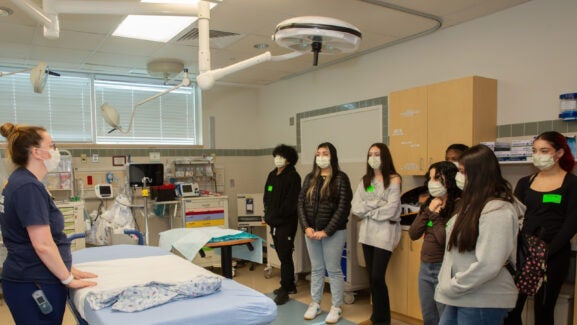

Safety and Security: Tips on Fire Prevention and Response
Every other Tuesday, Jeff Smith, Senior Manager of Compliance and co-chair of the Fire Safety Workgroup, takes part in Tuesdays Before Two. Joining around a dozen of our hospital leaders, he rounds various units throughout the hospital looking for potential safety or security hazards. Some of the most common infractions are habits and behaviors that can impact fire safety. Below, Smith provides some reminders and tips on fire prevention and response.
Battery Disposal
Alkaline batteries — AA, AAA, C, or D — may be safely disposed of by putting them in the trash. But if you have a 9-volt battery, there’s one extra step you need to take before it gets tossed. The National Fire Protection Association (NFPA) recommends taping the terminals or the top of the battery first. Why? Because the positive and negative posts are close together, and if a metal object touches them, it can short circuit and make enough heat to cause a fire.
This is something to keep in mind when storing 9-volt batteries as well. Keep them in the packaging if possible and avoid storing them loose in a drawer alongside paperclips or other metal items. “This is a good reminder for our staff when they’re at work or at home,” says Smith.
Should you have a different type of battery that needs to be disposed of, contact Waste Management to ask about the possibility of recycling.
Hallway Clutter
One of the most common fire hazards in our hospital, according to Smith, is cluttered hallways. Equipment and supplies often end up blocking important fire safety features like pull stations, electrical panels, and shut-off valves. “During our Tuesdays Before Two safety rounds, we almost always find at least one blocked pull station,” he says. It’s matter of convenience: placing things where they’re easy to grab instead of where they can be stored safely. Items that are out of place may prevent timely fire alerts and hinder evacuation.
Fire Doors
Fire doors are designed to slow the spread of fire and smoke, but they can’t do their job if they’re propped open. While this issue has improved, it still happens occasionally, particularly in clean storage locations. Smith says it’s important to make sure fire doors stay closed unless they’re actively in use, and if you notice a damaged fire door, report it to Facilities Management right away.
Overloaded Power Strips
Power strips are permitted at desks or work stations. But they shouldn’t be used as a primary power source for copiers or other equipment. “We’re consistently having them removed for safety,” says Smith. “If your area lacks sufficient power outlets, enter a request for the installation of additional permanent power outlets. The effort will resolve the problem and keep us safe.”
Hand Sanitizer Stations
Placing a waste bin under a hand sanitizer station may seem like a good idea; the trash can will catch drips and keep sanitizer off of the floor. But hand sanitizer is made of alcohol, so it’s extremely flammable and can ignite easily.
Smoke Zones
The hospital is divided into “smoke zones” or “smoke compartment designations.” Knowing which smoke zone you’re in is key to making sure you can respond quickly to an alert, and properly egress from that location in an emergency. Consult your Red Book for fire evacuation maps specific to your area.
“My team is in the process of helping Emergency Management put more clear mapping in the Red Books, so that unit staff can see the outline of their smoke compartment, and how to easily get outside of their smoke compartment,” says Smith. “Typically, especially in the hospital, moving to the next compartment during a fire event is the way to get to safety. It's not necessarily evacuating the building. Ensuring staff are knowledgeable about clearing the corridor and moving patients to the next compartment is something we regularly work on with staff, so they are at their best during events.”
RACE and PASS
Often on his rounds, Smith will quiz staff on their knowledge on how to respond to a fire. “It is a regulatory requirement that staff be able to answer how they would respond to a fire emergency. And the right answer is to apply the RACE acronym to the scenario that's being described to them,” says Smith. “I would say we have about a 50% success rate, which can be improved if unit leaders also quiz their staff routinely.”
Every UVA Health employee should be familiar with these two acronyms:
- RACE – Rescue, Alarm, Confine, Extinguish/Evacuate
- PASS – Pull the pin, Aim the nozzle, Squeeze the trigger, Sweep side to side
Although UVA Health doesn’t require staff to respond to a fire with a fire extinguisher, knowledge of how to apply the PASS acronym in a scenario is still something to be familiar with. “You should be able to demonstrate PASS knowledge and that you know where your nearest fire extinguisher is located, which are both required,” says Smith.
Latest News





